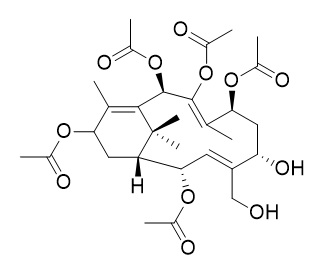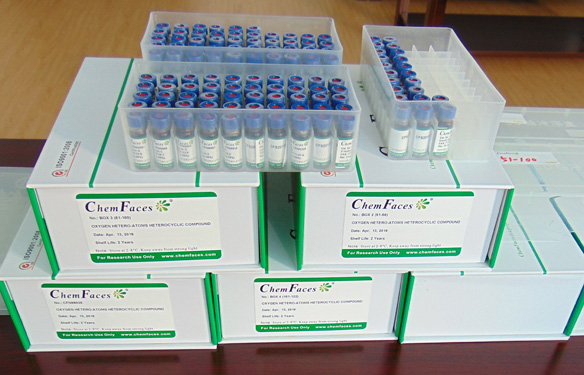Providing storage is as stated on the product vial and the vial is kept tightly sealed, the product can be stored for up to
24 months(2-8C).
Wherever possible, you should prepare and use solutions on the same day. However, if you need to make up stock solutions in advance, we recommend that you store the solution as aliquots in tightly sealed vials at -20C. Generally, these will be useable for up to two weeks. Before use, and prior to opening the vial we recommend that you allow your product to equilibrate to room temperature for at least 1 hour.
Need more advice on solubility, usage and handling? Please email to: service@chemfaces.com
The packaging of the product may have turned upside down during transportation, resulting in the natural compounds adhering to the neck or cap of the vial. take the vial out of its packaging and gently shake to let the compounds fall to the bottom of the vial. for liquid products, centrifuge at 200-500 RPM to gather the liquid at the bottom of the vial. try to avoid loss or contamination during handling.
Biological Sciences, 2007.
Studies on Diterpenoid Constituents from Taxus sumatrana in Taiwan.[Reference:
WebLink]
Taxol is a complex polyoxygenated diterpene isolated from Pacific yew (Taxus brevifolia). The structures of Taxoids are diversified with species, season and growth environment and the clinical effectiveness of Taxol as a microtubule-stabilizing therapeutic agent for treatment of several malignancies has motivated many scientists to isolate new taxoids and investigate their anti-tumor activities.
METHODS AND RESULTS:
In this continuing search for new and bioactive natural taxoids, reinvestigation of the acetone extract of the twigs, needles and branches of Taxus sumatrana (Taxaceae) afforded thirty-seven taxane diterpenes esters, including sumataxins sumataxin A (1)¡Bsumataxin B (2)¡Bsumataxin C (3)¡Bsumataxin D (4)¡Btaxuyunnanine C (5)¡B5a,7B,9a,10B,13a-petaacetoxy-4(20),11-taxadiene (6)¡B2a,5a,9a,10B,14B-pentaacetoxytaxa-4(20),11-taxadiene (7)¡B14B-hydroxytaxusin (8)¡B2a-deacetoxytaxinine J (9)¡Btaxa-4-(20),11-diene-2a,5a,7B,9a,10B,13a-hexaol hexaacetate (10)¡B1-dehydroxy baccatin VI (11)¡B7B,9a,10B,13a,20-pentaacetoxy-2a-benzoyloxy-4a,5a-dihydroxytax-11-ene (12)¡Btaxacin (13)¡Bbaccatin VI (14)¡Btaxuspinanane J (15)¡B2-deacetoxy-5-decinnamoyltaxinine J (16)¡BN-Methyl taxol C (17)¡B10-deacetyl yunnanaxane (18)¡Btaxumairol B (19)¡Btaxinine M (20)¡Bbaccatin III (21)¡Btaxuspinanane I (22)¡Btaxumairol K (23)¡Bwallifoliol (24)¡B13-oxo-baccatin III (25)¡Btaxol (26)¡B7-epi-10-deacetyl taxol (27)¡B10-deacetyl-13-oxo-baccatin III (28)¡B19-hydroxybaccatin III (29)¡B10-deacetyl taxol (30)¡B10-deacetyl-baccatin III (31)¡B13-acetyl-13-decinamoyltaxachinin B (32)¡B5-deacetyltaxachitriene B (33)¡B5-Epicanadensene (34)¡Btaxezopidine F (35)¡B13a,7B-diacetoxy-2a,5a,10B-trihydroxy-9-keto-2(3¡÷20)abeotaxane (36)¡B2-deacetyl taxine B (37). The structures of new compounds were established on the basis of their spectroscopic analyses.
CONCLUSIONS:
Among them, compounds 1, 2, 3 and 4 are new compounds from natural source, 2a-deacetoxytaxinine J (9)¡Btaxuspinanane J (15) had effects on PBMC (Peripheral Blood Mononuclear Cells) proliferation, and sumataxin A¡BD (1¡B4) had light exhibitedactivity of HSV-1.



